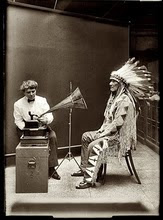
"Mao," Andy Warhol, 1972 (the same year as Nixon's famed Beijing visit)
An artist is somebody who produces things that people don't need to have. - Andy Warhol
At the apex of his career, Andy Warhol, that most famous of pop artists, was enlisting the help of dozens of assistants at his studio ("The Factory") to crank out copy after copy of his iconic silk-screen prints. It was the very reproducibility of his work which formed the statement of his oeuvre. He would furiously roll out variated prints--sometimes hundreds--in every different shade of vivid Technicolor, of Hollywood dons and divas, of shrill crimes stories and gory tragedies, of the wide-eyed imagery of the American imagination. He would feed the vast maw of celebrity and sensationalism with every imaginable perspective of every glowing little interest to fall before the eyes of a rabid and adoring audience public.
In fact, it was the interchangeability of the artist himself which Warhol implied with his famous quote: "Everyone will be famous for 15 minutes." He had shown the world that even an "ugly Polish queer from the Midwest" (of negligible formal talent) could ensconce himself within the iridescence of New York City and its most beautiful people. Today, the image of Warhol, like his multicolored prints of Marilyn Monroe, has outshone and outlasted its subject.
What do we then make of Shenzhen, in southern China’s Guangdong province? A former fishing village, Shenzhen was chosen as the first of the country’s Special Economic Zones by Deng Xiaoping in 1979. Today, this gushing city of eight million is the fountainhead of most reproduced art in the world. For less than $100, the global art consumer can commission a Rembrandt, Monet or Jasper Johns--or just a oil-painted copy of their graduation photo. It will be available at the doorstep of their similarly-reproduced colonial, Cape Cod or Tudor-style 4 bedroom, 2.5 bath. A copy of a copy....

Photo Credit: Spiegel Online
According to the UN, bulk US imports of Chinese oil paintings totaled over $64 million dollars in 2006, more than double the figure recorded two years earlier.
Are these millions of stretched canvases the ultimate realization of Warhol's postmodern dream, or are they a travesty of the artistic process? Wretched bastard children of automatons laboring away for 12-hour-days in sweatshop "art factories," as if they were sewing Nike's or lead-painted toys?

Photo Credit: Spiegel Online
And what do we make of the buyers of such paintings? Do they consider these works of human hands "art?" Though aforementioned figure $64 million worth of reproduced paintings shipped to American living rooms and hotel lobbies seems large, it's dwarfed by the price of a single painting, Jasper John's 1959 False Start, which sold for a record $80 million that same year.
Would anyone be willing to spend $80 million on a modern, original Chinese work (i.e. not a copy of Flemish realism or a porcelain vase dating from the Ming Dynasty)?
"What crap, this will never sell, Kim! The client wanted a Mona Lisa with her face on it...and for God's sake, make her look thin, man!"
I have an inkling that that will have much to do with the relative socioeconomic power and international standing to which China can lay claim to at point of sale. Perhaps the delicate brush-strokes, and graceful minimalism of the Middle Kingdom's indigenous style will demand their own dominant cache in years hence. Perhaps Chinese art will go the way of Japanese auto manufacture: from cheap, inferior knock-offs of Western designs, onward to internationally-acknowledged standards of excellence.
Since fashion is art now, and Chinese is in fashion, I could make a lot of money. -Andy Warhol, 1971 (one year before his "Mao" print series)

What's wrong with buying a copy?
ReplyDeleteArt has been priced outside of anyone's reach except the rich.
I've made several copies myself for friends.
Better the Chinese make art than a lot of the crap they make for Wall Mart. Hell, it's not like a Warhol is anything special anyway.
He was quite the asshole for making images that strip the meaning from themselves..he doesn't care if he paints a mass murderer like Mao or a saint...as long as he can sell them; so he's more of a whore than any copier.
And try to actually look at the Mona Lisa...it's got a fucking fence around it and glass over it now...and a gaggle of tourists who don't really care about art in general...they just want to say they saw it.
I bet a lot of those who buy the copies really love art.